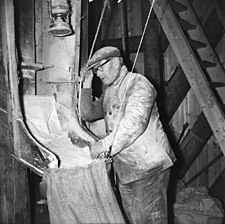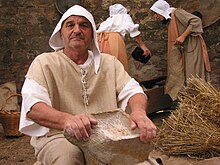Miller
This article needs additional citations for verification. (June 2013) |
 Miller at work in the De Hoed, Waarde windmill, Netherlands. | |
| Occupation | |
|---|---|
Occupation type | vocation |
Activity sectors | Agriculture |
| Description | |
| Competencies | Buying & Selling, Math, Machine repair, |
A miller usually refers to a person who operates a mill, a machine to grind a cereal crop to make flour.
Description
Milling is among the oldest of human occupations. "Miller", "Milne" and other variants are common surnames,[1]: 165 as are their equivalents in other languages around the world ("Müller" or "Mueller" in German, "Molnár" in Hungarian, "Molinero" in Spanish, "Molinaro or Molinari" in Italian etc.). Milling existed in hunter-gatherer communities, and later millers were important to the development of agriculture.
The materials ground by millers are often foodstuffs and particularly grain. The physical grinding of the food allows for the easier digestion of its nutrients and saves wear on the teeth. Non-food substances needed in a fine, powdered form, such as building materials, may be processed by a miller.

The most basic tool for a miller was the quern-stone—simply a large, fixed stone as a base and another movable stone operated by hand, similar to a mortar and pestle. As technology and millstones (the bedstone and rynd) improved, more elaborate machines such as watermills and windmills were developed to do the grinding work. These mills harnessed available energy sources including animal, water, wind, and electrical power. Mills are some of the oldest factories in human history, so factories making other items are sometimes known as mills, for example, cotton mills and steel mills. These factory workers are also called millers.
The rynd in pre-reformation Scotland was often carved on millers' gravestones as a symbol of their trade.
In a traditional rural society, a miller is often wealthier than ordinary peasants, which can lead to jealousy and to millers being targeted in bread riots at times of famine. Conversely, millers might be in a stronger position vis-a-vis feudal land owners than are ordinary peasants.

The traditional carnival held annually in the city of Ivrea, Italy commemorates a spirited "Mugnaia" (miller's daughter) who supposedly refused to let a local duke exercise his right of the first night, and proceeded to chop the duke's head off and spark a revolution. Whatever the historical validity of the story, it is significant it was the daughter of a miller to whom folk tradition assigned this rebellious role.
See also
- Gristmill, a name for grain mills
- Medieval watermills, a list of early medieval watermills
